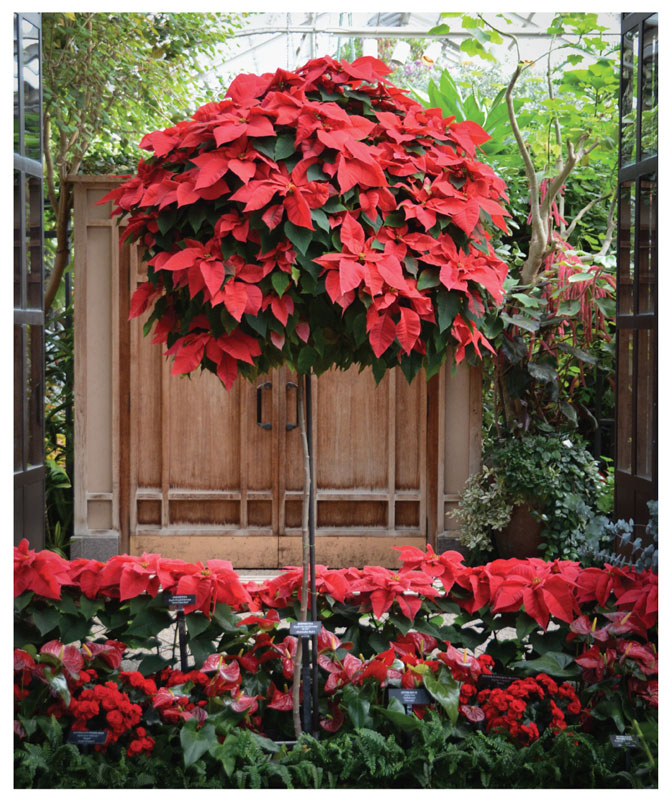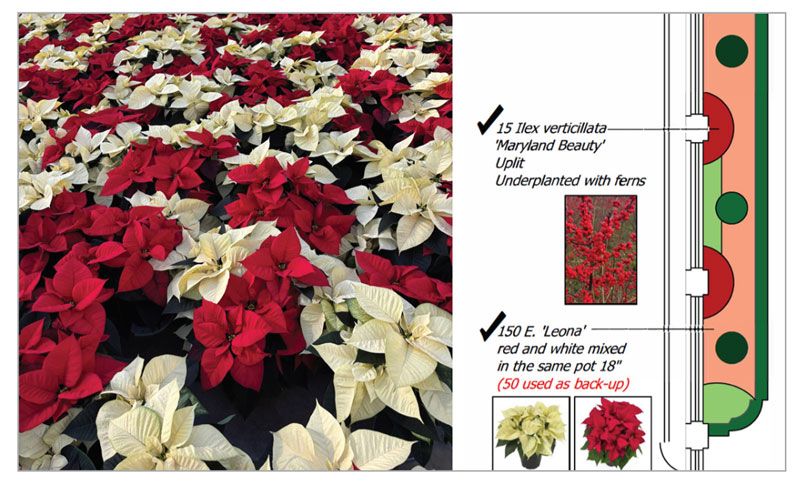9/30/2025
The Height of Holiday Horticulture
John Leader, Jim Sutton, Jessica Turner-Skoff & Kate Santos

At Longwood Gardens, located in Kennett Square, Pennsylvania, we view the poinsettia as more than a holiday staple—it’s an opportunity to showcase horticultural excellence. With more than half a million guests visiting our gardens between Thanksgiving and New Year’s—and millions more engaging with us through digital platforms and media—each year, we aim to create an engaging holiday experience that features unique horticultural moments. We achieve this through creating imaginative displays that highlight two important components: exceptional cultivars and advanced horticultural techniques. Showcasing unique—and not often seen— cultivars each holiday season and growing poinsettias in a variety of ways, from three-stem forms to towering 6-ft. poinsettia standards, we create countless holiday “wow” moments.
Our three-stem forms provide a striking background that showcases one of our 6-ft. tall poinsettia standards.
Cultivar selection
Each year, we conduct evaluations of new poinsettia cultivars—grown in three different forms—to assess their display quality. Our collaborative selection process includes input from our production, conservatory and design teams, and is guided by five key characteristics:
- Vigor: While industry may favor smaller plants, our conservatories are vast, so we prioritize presence—our tallest reach 36 to 40 in. in 28 weeks. Our shortest are 15 to 18 in. in 20 weeks.
- Bract size: Oversized bracts make a bold visual impact, drawing in guests of all ages.
- Longevity: With a minimum of a five-week display, we prioritize strong color retention and resistance to edge necrosis.
- Color (under varied lumens): Our display runs from 10:00 a.m.–11:00 p.m., so we avoid dark reds that appear black at night. Only natural colors (no paints or dyes) are used, favoring vibrant orange-reds, scarlets, pinks, greens and whites.
- Novelty: Unique bract shapes, flecking and non-traditional colors distinguish our display and captivate guests.
Three-stem forms
The three-stem technique is one of our most useful tools for integrating plants into design, encouraging three large, evenly sized bract “flowers” arranged triangularly when viewed from above, allowing them to be installed like puzzle pieces to create seamless waves of color. Reaching 3-ft. tall, they also bridge the vertical gap between 6-in. pinched crops and our taller standards or single stems.
Training is meticulous. After potting the initial cuttings into 4-in. containers, the crop grows until seven to eight fully developed leaves appear. When six healthy nodes are present, the apical meristem is removed using a razor blade. Over two to three weeks, lateral buds break and plants are up-potted into 7- to 9-in. containers. Three uniform branches are then selected, supported and disbudded. This structure allows us to create movement and gravitas in large-scale plant designs.
Poinsettia standards
Our poinsettia standards elevate our display into an architectural and artistic experience. Six-feet tall with a 3-ft. canopy, these specimens are grown over 23 months using the vigorous, apical-dominant rootstock St. Louis (Bourdet). Cuttings are taken on Christmas Day, potted up and trained to a single leader. By August, they’re grafted with cultivars from the Nutcracker Series (Oglevee) and Maren (Beckmanns Altrosa). Grafting is difficult due to the plant’s hollow stems and milky sap; six to eight T-grafts are made per plant, with one or two likely to take.
Scions are pinched and trained into spherical canopies using string and support structures. Blackout begins 11 weeks before display—longer than typical crops—due to the size and grafted nature. Until then, long-day conditions promote vegetative growth.
 Integrating poinsettias into design
Integrating poinsettias into design
Design decisions blend nostalgia and novelty, transforming poinsettias into elements that guide movement, frame views and set the tone.
A trip to Lucas Greenhouse provided a source of inspiration with the pairing of Leona Red and Leona White in the same pot. The picture on the left is the inspiration, the picture on the right is our design.
Photo courtesy of Jim Sutton.
Tradition—rich, bright reds; classic forms—is balanced with innovation, featuring unique colors, shapes and textures. From historic cultivar series no longer available in the industry that we keep our own stock of, like Santa Claus (Selecta One), to new reds, with round bracts like Christmas Mouse (Selecta One) to white carnation-like bracts of Roccostar (Lazzari) to chartreuse yellows and beyond, our displays offer guests an elevated poinsettia experience.
Nine large walkways throughout our conservatory include at least one cultivar and up to 300 poinsettias, thus offering nine distinct experiences. Poinsettias are paired with complementary foliage plants, lit evergreens and accents like hanging guzmania baskets to create immersive, layered compositions.
Our horticulturists and designers work together from concept to execution. A recent visit to Lucas Greenhouses in Monroeville, New Jersey, sparked the idea of using Leona Red and Leona White (Beekenkamp) combined in a single large pot. This retail concept is now being adapted as part of our 2025 display.
Looking ahead
Our poinsettia production is a fine-tuned art. As temperatures rise, we’re evaluating heat tolerance in cultivars, as well. Displays also continue to evolve as our indoor and outdoor holiday displays grow and require more innovation. We’re also considering showcasing our poinsettia techniques in other seasons—though, of course, we’d never use red after Christmas!
By aligning horticulture with design, assessing new cultivars, and continuing to refine and innovate our methods to grow poinsettias in unusual ways, we’re reimagining this holiday staple to not only make it feel fresh, but to bring joy, wonder and inspiration to our guests. GT
John Leader is Floriculture Manager; Jim Sutton is Associate Director of Display Design; Jessica Turner-Skoff is Associate Director of Science Communications; and Kate Santos is Associate Vice President of Science at Longwood Gardens.